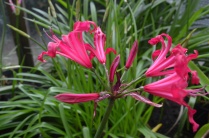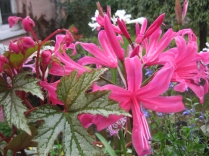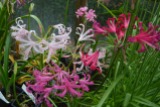There is always a long awaited treat in October when my nerines come into full beauty. Some of them start in September, but October is the month when they are all strutting their stuff, each more lovely than the last. The bowdenii hybrids can live outside and they make ever larger clumps.

Nerine bowdenii
I particularly enjoy the pale pink Nerine bodwenii ‘Pink Surprise’. The flowers are so delicate.

Nerine ‘Pink Surprise’
The ones with sarniensis blood have to stay inside. The lovely vermilion-red Nerine sarniensis starts blooming in September but it has to live in the house in winter as it is too delicate for outside. It produces its leaves in winter and these would be killed by the first frost. I keep all my sarniensis/ bowdenii hybrids in an unheated greenhouse but I cover them with fleece when it is very cold. Favourites include the shimmering dusky flowers of ‘Mr. John’.

Nerine ‘Mr. John’
And the huge dark pink flowers of Nerine ‘Zeal Giant’.

Nerine ‘Zeal Giant’
Gleaming white Nerine bowdenii ‘Ella K’ should be hardy but I find that white nerines don’t seem to be as hardy as the pink ones. This one starts blooming in September.

Nerine ‘Ella K’
When ‘Ella K’ is going over then Nerine bowdenii ‘Alba’ takes over.

Nerine bowdenii ‘Alba’
Best of all though is my wonderful plant of the delicate Nerine undulata. This year there are 46 blooms in the one pot. I suppose I really should think of dividing it, it has lived for so long in the same pot. This has to be done in spring.

Nerine undulata
My number two favourite is Amarine belladiva which is a cross between nerine and amarylis. The flowers are much bigger than nerines. I have ‘Aphrodite’ which has delicately stripped flowers. It is supposed to be hardy so this year I am risking it outside. It is a good idea to mulch nerines and amarines because the embryonic buds are vulnerable to frost.

Amarine belladiva ‘Aphrodite’
My number three is a little plant which I cosset in the greenhouse. It is actually an oxalis but forget the horrors of that creeping weed with red leaves; Oxalis corniculata that gets everywhere. This is an aristocratic little plant from South Africa which sits politely in its pot and causes no trouble. And very pretty it is too. It blooms right through the autumn.

Oxalis massoniana
While we are in the greenhouse I might as well include the little paint brush plant haemanthus. It usually comes in red but this is Haemanthus albiflos. The chilli plant in the picture is ‘Apache’, I always grow two or three plants of this, it makes a nice compact plant and fruits prolifically.

Haemanthus albiflos
I am not very keen on fuchsias. They look as if they are wearing the kind of dresses I loved when I was six, pink with frou frou skirts. My tastes have changed now. But I am very fond of a hardy climbing fuchsia called Lady Boothby. It is hardy down to -10. The flowers are a lovely shiny red and purple. I think a climbing fuchsia is rather unusual. I bought it at East Ruston Old Vicarage gardens, you can always be sure of finding something unusual there.

Fuchsia ‘Lady Boothbury’
Of course we have to include Michaelmas daisies in a list of October favourites. The naming of these plants has become a minefield. An aster is no longer a simple aster, or not always anyway.
My favourite is – come on, let’s give it its proper name , Symphyiotrichum ‘Vasterival’. As you would expect from a plant from this fabulous garden, ‘Le Vasterival’ it is a real beauty. The late Princess Sturdza who gardened near Dieppe in France was an amazing gardener and the garden was one of my all time favourites. She was a very scary lady though. She used to conduct her guided tours clutching a pitchfork and she poked people with it if she felt they were getting too close to the edge of the borders.
S.‘Vasterival is a tall growing aster with masses of starry flowers on black stems. It is ethereally delicate and airy and although it spreads and languorously leans all over neighbouring plants I smile indulgently at it and allow it the sort of behaviour that lesser beauties wouldn’t get away with.

Symphyiotrichum ‘Vasterival’ with Anemone x hybrida ‘Andrea Atkinson’
Most people wouldn’t put Japanese Anemones in their top ten favourite lists, they are very invasive. I dug this white anemone up last year as I thought it was too near the front of the border. But this year she blooms on, serenely unconscious of the fact that she is not supposed to be there. But the flowers are such a pure white and the blooms last much longer than on other Japanese anemones. The name is Anemone x hyrida ‘Andrea Atkinson’. It is very similar to the more common ‘Honorine Jubert’ but I think it is better. It looks lovely with S.’Vasterival’.
I have rather a lot of asters and I haven’t room to describe them all so I’ll just show you another favourite. It is Symphyiotrichum ‘Little Carlow’. It is much better behaved than ‘Vasterival’ and stays nice and compact without falling all over. It is a cordifolius hybrid . I have one by my garden gate and total strangers knock on the door to ask its name.

Symphyiotrichum ‘Little Carlow’
The centres of the flowers are yellow but they are always abuzz with bees and once the flowers are pollinated the centres turn pink. They look pretty with the dark pink flowers of Persicaria amplexicaulis ‘Blackfield’.

Persicaria are very useful for late summer and autumn colour. Like the asters they have suffered from a name change, which is a shame as rather childishly, I always used to enjoy Polygonun ‘Superbum’. As they are knotweeds most of them spread to make nice big clumps. Cathy at ramblinginthegarden has a good collection of these useful plants. She very kindly sent me Persicaria microcephala ‘Red dragon’. It has lovely dark red leaves with grey veins.

Persicaria microcephala ‘Red Dragon’
I’m not always sure of the names of the persicaria that I have begged or borrowed but I think the next one is Persicaria campanulata. It’s one I – er- borrowed. It’s alright, it spreads so fast nobody is going to miss a tiny little piece.

Persicaria campanulata
The pink and white Persicaria amplexicaulis look good growing with Sambucus nigra ‘Black Lace’

My next plant has suffered from a name change too. It used to be a chrysanthemum, but no longer. I think it is now called Arctanthemum arcticum. it is an arctic daisy which spreads into lovely clumps and has gleaming, snow white flowers. I love it.

Arctanthemum arcticum
Next month there will be more chrysanthemums as they are the stars of November.
I will finish with something a bit weird and wonderful.It is new to me this year. It is a succulent called Orostachys iwarenge, or Chinese Dunce Cap. It has rosettes from which grow little conical caps of pink flowers.

Orostachys iwarenge
So that’s my list of ten favourites for October. Here in Suffolk the weather has been unseasonably warm and the flowers seem to think that it is still summer. Other parts of the country have had gales and the tail end of Ophelia, but here we have just had incredibly warm days and a peculiar amber sky which then turned yellow and glowed with an eerie light. I hope that you have still got plenty to enjoy in the garden and that you will join me and show us which plants you are enjoying this month.



































































































































